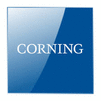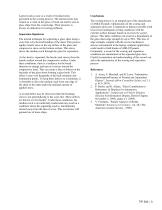
Catalog excerpts

Scoring of AMLCD Glass Technical Information Paper TIP 302 Issued: November 2004 Supercedes: November 2001 R. A. Allaire and J. C. Lapp Technology Group, Corning Incorporated, Corning, NY 14831 Paper presented at Display Works 1996 – San Jose, CA Abstract The scoring process is often used for sizing of glass sheets, the score wheel generates a small crack on the glass surface, which is then propagated through the glass for complete separation. This report will present a description of the scoring process and an interpretation of the marking found on the substrate edges from the point of view of AMLCD fabrication. open crack, forcing the crack open with a wedging action. The scoring wheel penetrates into the glass surface only to a depth of 2-5 µm, yet the median crack typically reaches a depth of 50 - 120 µm. The individual panels are then separated by the application of a bending stress for driving the median crack through the glass thickness. In addition to driving the median crack along the glass surface, the scoring process results in other changes to the glass surface. The contact stresses imposed by the rolling wheel creates a damage zone 3-7 µm deep. The glass responds to the creation of this region through a combination of plastic flow and brittle failure1. The former results in densification of the glass, while the latter results in the formation of microcracks either on, or slightly below, the glass surface. These microcracks can, in turn, form the nuclei for larger cracks known as lateral cracks. Recent work has shown that the presence of these cracks have a significant impact on the edge strength2. Extensive lateral cracks may also result in the creation of glass chips. Figure 1 schematically illustrates these principles. The scoring process is often used as a reliable and inexpensive method for sizing of glass sheets. Glass substrate manufacturers use it for removing undesirable portions of their formed sheet and for sizing of the glass (mother sheet) to the customers specifications. AMLCD manufacturers use the scoring process to do the final separation of the individual display panels. Fundamentals of Scoring In the scoring process, a score wheel is used to generate a median or vent crack in the glass surface. As the wheel rolls on the glass, the median crack is pushed downward and ahead of the wheel. The wheel rides on top of an
Open the catalog to page 1
In an optimum score, the bottom of the median crack should be straight, continuous, unwavering, and parallel to the face (top) surface of the glass. Such a feature indicates the wheel is running freely and true in its holder, and that it has sufficient force and time to complete its wedging action. Below the median crack is the smooth break surface. This region was formed as the sheet was separated. A smooth surface is characteristic of a good quality break. Characteristics of a Poorly Scored Edge For the purposes of cleanly separating the glass sheet, it is the goal of the scoring process...
Open the catalog to page 2
Lateral cracks occur as a result of residual stress generated in the scoring process. The lateral cracks may remain as a crack in the glass or break out and be seen as glass chips from the scored edge. Their presence is always an indication of scoring problems. Separation Signatures The normal technique for separating a glass sheet along a score line is by flexural bending of the sheet. This process applies tensile stress at the top surface of the glass and compressive stress on the bottom surface. This stress drives the median crack through the glass for separation. As the sheet is...
Open the catalog to page 3
North America and all other Countries Corning Display Technologies MP-HQ-W1 Corning, NY 14831 United States Telephone: +1 607-974-9000 Fax: +1 607-974-7097 Internet: www.corning.com/displaytechnologies Japan Corning Japan K.K. Main Office No. 35 Kowa Building, 1st Floor 1-14-14, Akasaka Minato-Ku, Tokyo 107-0052 Japan Telephone: +81 3-5562-2260 Fax: +81 3-5562-2263 Internet: www.corning.co.jp Nagoya Sales Office Nagoya Bldg., 7 F 4-6-18, Mei-eki, Nakamura-ku Nagoya-shi, Aichi 450-0002 Japan Telephone: +81 52-561-0341 Fax: +81 52-561-0348 China Corning (China) Ltd., Shanghai Representative...
Open the catalog to page 4All CORNING Display Technologies catalogs and technical brochures
-
Gorilla® Glass 5
2 Pages
-
Corning Iris®
2 Pages
-
Aspheres by Corning
2 Pages
-
UltraFlat™
2 Pages
-
Tropel® FlatMaster® MSP
2 Pages
-
Optical Solutions
4 Pages
-
EAGLE XG® Slim
2 Pages
Archived catalogs
-
Jade® Product Information Sheet
3 Pages
-
Jade® Material Information Sheet
2 Pages

































